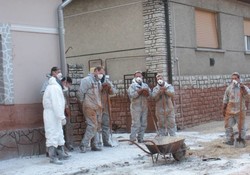Activities

WHO/Roger Aertgeerts
WHO/Europe supports countries’ efforts within the frameworks of global and regional commitments to reduce and eliminate health risks from hazardous chemicals throughout the life-cycle. The Ostrava Declaration, adopted by the Sixth Ministerial Conference on Environment and Health in 2017, identified priority actions such as developing national policies and strategies, promoting exposure assessment and the use of human biomonitoring, ensuring capacities to respond to existing and new challenges, encouraging substitution of hazardous chemicals and improving information availability, and promoting research to better understand human exposure to chemicals and the associated burden of disease.
Capacity-building and networking
The rapid development of new technologies, the growing chemical products market and recent knowledge about the health effects of exposure to chemicals at the early stages of life require joint action by the scientific community, national authorities and other stakeholders to facilitate the development and enforcement of preventive measures. Adequate capacities should be created to ensure their effectiveness. Current WHO/Europe activities focus on:
- health system preparedness and response to chemical-related emergencies and International Health Regulations (IHR) (2005) implementation;
- implementation of the Strategic Approach to International Chemicals Management (SAICM) and other international agreements;
- implementation of commitments from the Ostrava Declaration;
- assessment of the risks of chemicals and their mixtures;
- building analytical potential, especially for human biomonitoring.
Policy development and implementation
WHO/Europe guides the development of policy and implementation of actions to reduce and prevent environmental health risks from chemicals, especially among vulnerable population groups. Currant activities focus on priority hazardous chemicals such as carcinogens, mutagens, reproductive and neurodevelopmental toxicants and endocrine-disrupting chemicals, whose effects are of particular concern for public health.
- The 2030 Agenda for Sustainable Development promotes a number of actions related to sound management of chemicals, which will support attainment of the Sustainable Development Goals (SDGs) and good health for all by contributing to poverty elimination, food security and health security. By 2030, SDG 3.9 calls for substantial reductions in the number of deaths and illnesses from hazardous chemicals and SDG 6.3 seeks to improve water quality by reducing pollution, eliminating dumping and minimizing release of hazardous chemicals and materials. SDG 12.4 strives to achieve environmentally sound management of chemicals and all wastes throughout their life-cycle, in accordance with agreed international frameworks.
- The WHO chemicals road map to enhance health-sector engagement in SAICM, towards the Health 2020 goals and beyond, has been supported by all WHO Member States.
- The Minsk Declaration on the life-course approach in the context of Health 2020 encourages Member States in the WHO European Region to pay specific attention to the protection of early childhood from hazardous chemicals.
- Implementation of the global legal instrument on mercury, the Minamata Convention, aims to alleviate economic and social losses caused by mercury-induced diseases and ill health; however, existing assessments are based on neurodevelopmental effects.
International legally binding and voluntary agreements highlight the crucial role of all stakeholders at the local, national, regional and global levels. WHO/Europe works towards strengthening coordination and cooperation at the regional and national levels.



